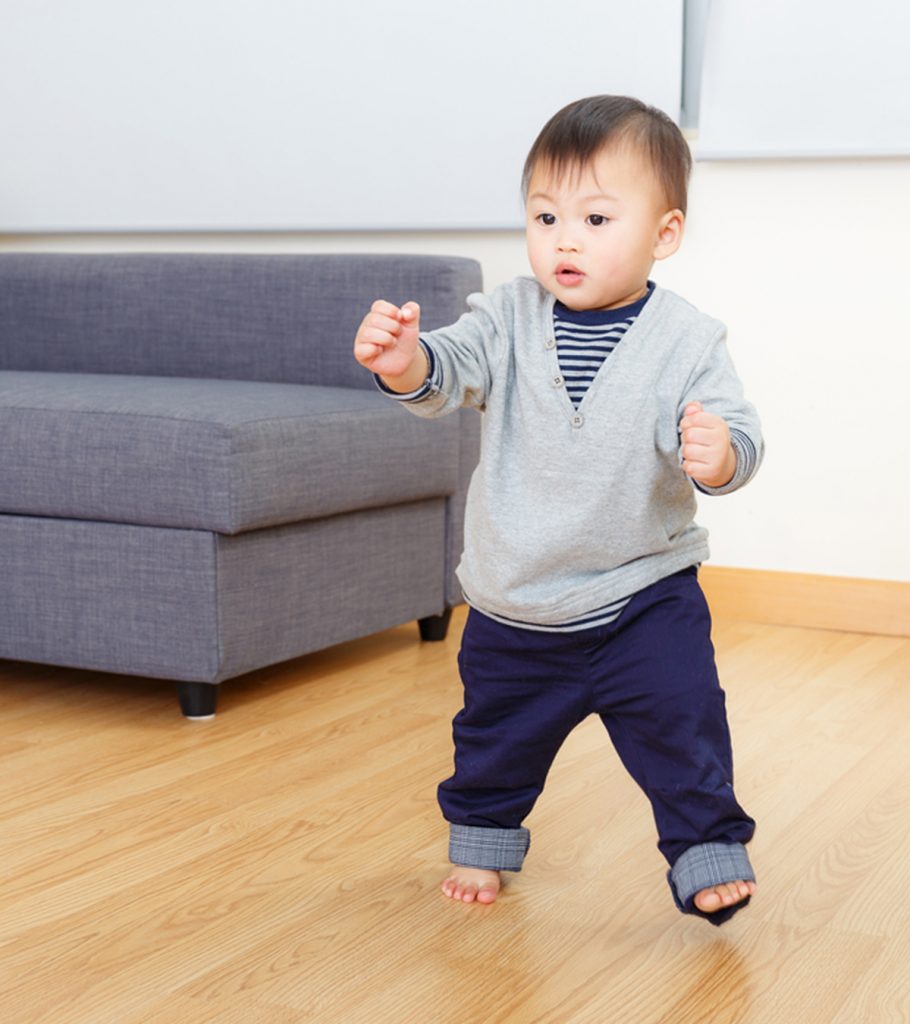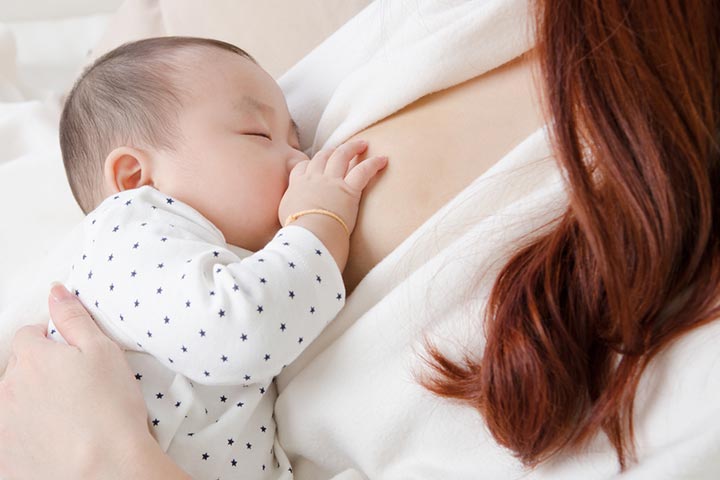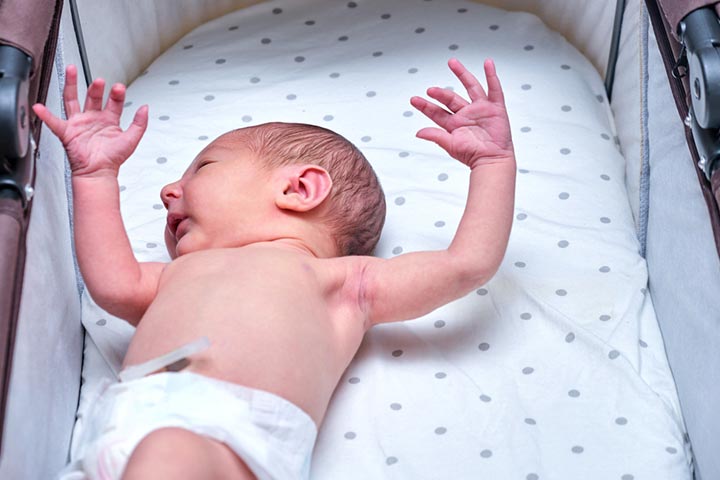The stepping reflex in babies is a crucial reflex that trains the baby’s leg muscles to prepare for crawling and walking. Generally, babies are born with several primitive reflexes, such as the stepping reflex, which help them survive after birth. Reflexes are automatic responses to a stimulus triggered by the central nervous system (CNS).
The presence of primitive reflexes in babies is a vital indicator of their normal growth and development. Stepping reflex is one of the first reflexes that a child will exhibit and one of the first reflexes to fade away.
Keep reading to learn more about the stepping reflex, its significance, and other primitive reflexes present in babies.
What Is Stepping Reflex?
Stepping reflex or step reflex occurs when a baby is held upright with the soles of their feet touching a flat, solid surface. The baby begins to place their feet one after the other, performing the stepping or walking action, which is an example of gross motor skills development (1). Do note that the infant can neither stand nor walk. Nevertheless, they will perform the stepping action. The reflex is also known as the walking reflex or dancing reflex.
Why Do Babies Have The Stepping Reflex?
The purpose of the stepping reflex is to help the baby crawl to their mother’s breasts when placed on the mother’s abdomen (2). Therefore, the reflex once played an essential role in the initiation of breastfeeding.
The reflex may also condition the baby’s leg muscles to prepare them for crawling and walking later in life and help build muscle tone. It may also help the baby’s nervous system exercise various motor neurons and neural pathways to stay prepared for crawling and walking when the time arrives.
When Does The Stepping Reflex Start And Stop?
The stepping reflex is present at birth and disappears once the baby is two months old. It is the first primitive reflex to disappear (2). The reflex re-emerges when the baby is 12 months old and ready to stand without support and walk eventually.
What If A Baby Has No Or Weak Stepping Reflex?
Consult a pediatrician in case the baby displays a weak or absent stepping reflex. A pediatrician will likely check for the reflex after the baby’s birth or during regular checkups. The absence of the stepping reflex or other primitive reflexes may indicate underlying problems with the central nervous system (CNS). The risk may be higher in the case of preterm babies.
Since the reflex only triggers when specific conditions are met, it may not always trigger. You may try multiple times. Determination of underlying CNS problems requires multiple assessments and the presence of other signs. If your baby shows the healthy achievement of cognitive, physical, and social developmental milestones, the absence of stepping reflex may not be a concern. Therefore, do not panic if the baby has an absent or weak stepping reflex. Speak to your baby’s pediatrician to assess and address any concerns.
Other Types Of Newborn Reflexes
Below are the other newborn reflexes found in babies (3) (4).
- Palmar grasp reflex: The newborn curls their fingers around an object or a finger when you stroke their palm with it. This reflex disappears by the age of six months.
- Plantar grasp: When you stroke the sole of the baby’s feet, the baby opens the toes and curls the feet inward. Plantar grasp disappears between nine and 12 months of age.
- Moro reflex: The baby reacts to a loud noise by throwing back the head, extending legs, arms, and neck, and then quickly bringing the arms closer to the body. The baby may also cry during the reflex. The Moro or startle reflex peaks around one month of age and disappears by the age of two months, although some babies may show it for a few additional months.
- Rooting reflex: When you stroke the corners of the baby’s mouth or cheeks, they turn their head in the direction of the touch. This reflex helps a newborn find the nipple and latch to it. This reflex goes away by four months of age.
- Sucking reflex: When a nipple is placed inside the baby’s mouth and touches their palate (mouth’s roof), they instinctively begin to suck. The sucking reflex helps initiate breastfeeding once the baby finds and latches to the breast after the rooting reflex. The sucking reflex also works when you place a finger or pacifier inside the baby’s mouth.
- Tonic neck reflex or fencing reflex: If the baby turns their head in a direction, the arm on that side stretches while the other arm bends at the elbow. Since it resembles a pose of a fencer, it is also called a fencing reflex. The reflex disappears between the ages of five and seven months.
- Galant reflex: It is also known as truncal incurvation reflex. When a baby is held head down, and her skin along one side of the spine is stroked, her spine curves, and her head and feet move toward the side being rubbed. It is thought to help the baby move in a wriggling motion while coming out of the birth canal (5) (6).
- Protective reflexes: These are reflexes that protect the body from harm and are not exclusive to infants. Examples include blinking eyes when something comes close to them, coughing, and sneezing (7).
The stepping reflex in babies is one of the body’s ways to prepare a baby for crawling, walking, and motor development. The reflex begins at birth and fades away at around two months of age and is estimated to help the baby reach out to the mother during breastfeeding. Its reappearance around nine to 12 months is a sign of celebration as the reflex assists the baby when it starts walking. Since this reflex has a crucial role, it is checked by the doctor during regular check-ups. The absence may indicate an underlying CNS problem. Hence, consult your pediatrician if you suspect a leak or an absence of stepping reflex.
Key Pointers
- Step reflex helps babies crawl to their mothers’ breasts when placed on the abdomen.
- The stepping reflex disappears when the baby is two months and may re-emerge at around twelve months.
- Newborn reflexes in babies include palmar grasp reflex, plantar grasp, moro reflex, and rooting reflex.














